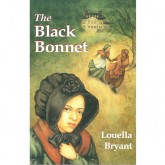Underground Railroad Project: The Black Bonnet
Funded by the Vermont Humanities Council. The following materials were compiled in 1997.

Louella Bryant is the author of The Black Bonnet which is a story about two sisters who escape slavery in Virginia in the late 1850s. They make their way to Burlington, where they stop to rest before completing their trip to Canada. Ms. Bryant has provided the Vermont Historical Society with a list of student activities and suggested projects which include links to related Civil War and Abolition topics.
Suggested projects to accompany The Black Bonnet
- Rewrite the novel as an illustrated story for young children. Try to keep as much of the plot and message as possible but put it in simpler language. One illustration per page.
- Create a scrapbook that might have been kept by one of the characters. Include pictures, souvenirs, newspaper articles, etc., that s/he would have in it. Explain the purpose of each.
- Create a detailed book jacket illustrating the novel. Be sure to include blurbs from critics and an intriguing plot summary, as well as a blurb about the author.
- Research and write a report on one of the following topics:
- The Dred Scott Decision
- The Fugitive Slave Act
- The Underground Railroad in Vermont
- The African Relocation Program
- Harriet Tubman
- Frederick Douglas
- John Brown
- Abraham Lincoln
- Design and create an ABC book or a children’s counting book, using the novel for your ideas. (For example, A is for Africa, the original home of the slaves.)
- Choose four characters from the novel and design a “baseball” card for each. The card should include the character’s name, nickname (create one if needed), the physical description, hobby and other pertinent information that would fit a standard baseball card. On the other side, draw a picture/representation of the character.
- Make a mobile using symbols, characters or scenes from the novel. On a separate sheet, or attached to each item, write a brief explanation of why the item is important to the story.
- Find five of your favorite quotes from the story and transcribe them in calligraphy and illustrate them.
- Write an obituary of Bea using facts from the novel and adding imaginary details from her later life.
- Complete a series of five detailed drawings that show five of the major events in the plot. Write captions for each drawing so that the illustrations could be understood by someone who did not read the book.
- Write a scene that could have happened in the novel, but didn’t. Try to use a style and language similar to the author. After the scene, write an explanation of how it would have changed the outcome of the story.
- Create a detailed time line of the novel. Include pictorial representation of events within the time line.
- Create a “video tour” of Burlington. Take the viewers on a walking tour of the downtown area and the street where Bea and Charity were hiding. As you go along, describe the homes and buildings, the characters and events which took place there. You may use musical background for your tape.
- Design a “Jeopardy” game for the class to use as a review. You will need categories, questions, and answers set up to play.
- Act out and videotape a scene from the novel. Refer to text to use actual dialogue to be accurate. Have video ready for class to see.
- Make a list of at least ten proverbs or familiar sayings. Then decide which of the characters in the novel should have followed the suggestion in the proverb and why. (Sample proverbs: He who hesitates is lost. All’s fair in love and war. The early bird catches the worm. A stitch in time saves nine.)
- Reread Bryant’s description of the teachers in Sissy’s school. Then write a descriptive passage of a person or specific place. Be very detailed, use vivid adjectives, and show--don’t tell. Your reader should be able to “see” the person or place.
- Write a review following the fictional “debut” of a stage production of The Black Bonnet. Draw on your “real” knowledge of the novel and create imaginary details of the performance, such as the effectiveness of the casting (you may indicate who plays which role), the closeness with which it followed the novel, any major deletions from the novel and what effect it had, etc. Your imaginary details should make your understanding of the novel obvious.
- Courage is a major theme in this novel. Write your own story of courage. Remember, courage can be as simple as telling the truth when a lie would be more convenient, or as complex as donating an organ to save a family member’s life. Your definition of courage should be obvious from reading your story. Your story may be fiction or nonfiction.
- Pretend you are a grown-up Charity after the Civil War has ended and write a letter to Master Pearson. You may take any approach you wish, but draw on Charity’s “childhood memories” in some way.
- Complete each of these eight ideas with your original thoughts inspired by this novel: This book made me wish that...; this book made me realize that...; decide that...; wonder about...; see that...; believe that...; feel that...; hope that... Each of your reflections should be a short paragraph and should indicate your understanding of the novel as well as your personal beliefs.Write a “Letter to the Editor” in the voice of one of Burlington’s citizens. Your letter can reflect either the abolitionist or anti-abolitionist point of view. Try to keep your language appropriate to the character whose voice you are assuming.
- Write a “Letter to the Editor” in the voice of one of Burlington’s citizens. Your letter can reflect either the abolitionist or anti-abolitionist point of view. Try to keep your language appropriate to the character whose voice you are assuming.